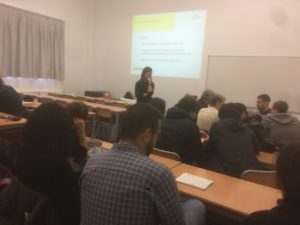In the framework of the H2020 European project Social Innovation Communites and after the development and participation in several seminars and workshops on social innovation and public policies, Sinnergiak Social introduced the policies of social innovation to the university community focusing on its characteristics and the available methodologies and tools that guarantee a socially innovative approach to the policymaking process. As a result of this internal reflection, this Masterclass was designed specifically addressed to the 4th year students of the Political Science degree at the University of the Basque Country / Euskal Herriko Unibertistatea.
The rise of the focus on social innovation and the emergence of digital and cooperative tools in social innovation to connect, promote shared awareness, and improve the living conditions of younger generations have proven to be important elements that can make a difference in the contents and the future design of public policies.
This session was focused on a participatory policy masterclass, in which on the one hand Sinnergiak Social Innovation, presented the Social Innovation Community (SIC) project and the 7 principles of social innovation policies and on the other hand, coordinated a workshop to learn about the use of 2 policy design tools (Challenge Setting and People) was developed.
About the Masterclass
The 6th of November the UPV / EHU organized a masterclass aimed at students of Political Science of the University of the Basque Country. The objective of the session was to introduce the students to the SIC project and the various methodologies that are being used for the co-creation of public policies.
After the presentation of the SIC and the 7 principles of the Social Innovation policies, the participants were introduced to the tools for co-designing public policies. The topic selected to work during the session was youth unemployment. In order to guide the session the following case was presented;
Topic: Youth Unemployment

The figures for youth unemployment in Spain place our country at the head of the EU and OECD countries. The high unemployment rates in the Basque Country’s youth population (23% in 2017) affect 9,000 young people between 16 and 24 years old. The high unemployment is related to the growing precariousness of wage labour, which affects especially the younger generations, and which implies impoverishment and a breakdown of their future socioeconomic expectations.
The participants were divided into 5 groups. Challenge setting was the first tool that was used. These tools helped us identify the main challenges younger generations are facing. The most relevant challenges were focused on the following ideas:
- Creation of an APP that facilitates job search for young people
- Encourage companies to hire young people without experience and with the possibility for their employees to be continually trained
- Promote professional training. Increase the duality of training to all areas of higher education.
- Promote courses / workshops for the specialization of young people
- Orient young people from the beginning of secondary education. This education should be associated with training specialization in association with employment needs.
- Stronger collaboration between University and business
- Improve the education system
Once this phase of brainstorming was completed, the 5 groups were asked to select one of the challenges that they had previously identified through a deliberative exercise. The 5 challenges presented by the groups were:
- Creation of an APP that facilitates the search for employment. Connect unemployed people to companies.
- Development of training and internship labour contracts
- Policies which cover 50% of the salary per every young person hired that facilitate hiring opportunities in companies
- Educational programs which have a pragmatic orientation towards the job market from high school with specialization towards work.
- Retirement policies based on relay contracts.
 This first exercise concluded with the application of the question: How can we? The answers to these questions provided us with some clues to have a better understanding of how people relate to the use of certain policies. The participants were asked to place organizations in the following matrix based on two ideas: the level of influence and the frequency of interaction with the policy or the service.
This first exercise concluded with the application of the question: How can we? The answers to these questions provided us with some clues to have a better understanding of how people relate to the use of certain policies. The participants were asked to place organizations in the following matrix based on two ideas: the level of influence and the frequency of interaction with the policy or the service.

Finally, and as a closing exercise, the participants were asked to make an effort to describe a day in the life of a person directly affected by the policy was like: either as a service provider or as a claimant of the service. In order to develop this exercise, the PERSONAS methodology was used. The objective of this tool is to understand the users of the service or the policy that is going to be implemented. Some examples of the cards completed by the students are shown in the following figure.
As a final reflection, it would have been nice to have a whole day to focus on these methodologies and techniques. As we moved forward during the workshop the interest, creativity and focus of the participants grew, and their capacity to think about the topic and find specific solutions improved. As a result, we found that a three-hour policy workshop was not enough to find specific results and measures, more time is needed. By the time that participants were hooked, the workshop was over.
For more information on tools and methods check the following link: SIC Repository
For more information about the workshop: iguerra@sinnergiak.org
aluna@sinnergiak.org
About the SIC
Social Innovation Community (SIC) is a European project funded under the H2020 program framework, and is integrated by a consortium of 12 different European organizations amongst which is Sinnergiak Social Innovation. The overreaching aim of this project is to create a “network of networks” of social innovation actors. SIC aims to deepen and strengthen existing networks, forge new connections between networks, and create new links to actors and networks which hitherto have not been included in the field of social innovation. The aims of such a community are to generate new social innovations, develop and scale up successful social innovations and to share and spread knowledge more effectively in order to improve practice and policymaking.
For more information: iguerra@sinnergiak.org
aluna@sinnergiak.org
